CADILLAC ELDORADO 1996 10.G Owners Manual
Manufacturer: CADILLAC, Model Year: 1996, Model line: ELDORADO, Model: CADILLAC ELDORADO 1996 10.GPages: 354, PDF Size: 19.33 MB
Page 91 of 354
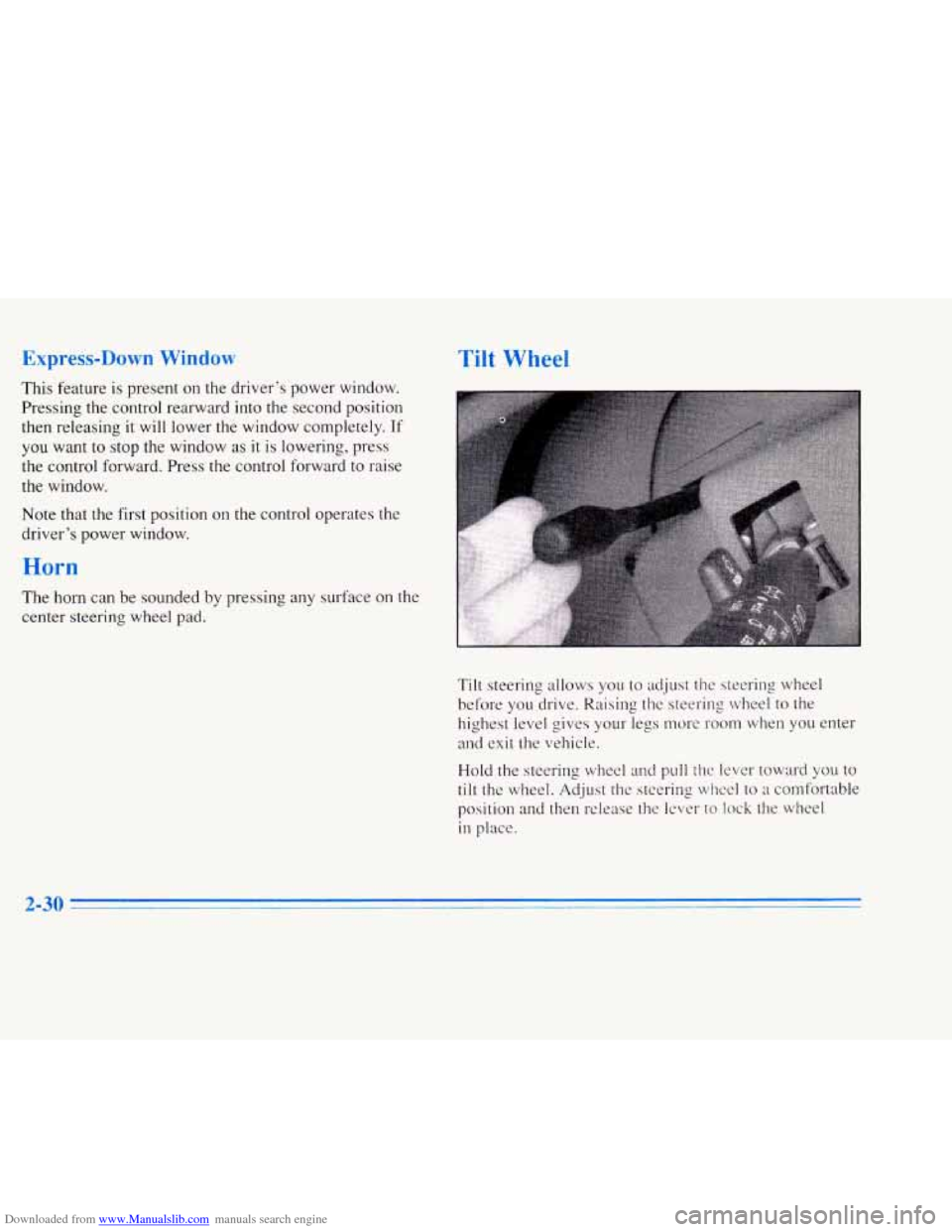
Downloaded from www.Manualslib.com manuals search engine 111 vv heel
This feature is present on the driver's power window.
Pressing the control rearward into
the second position
then releasing it will lower the window completely. If
you want to stop the window as it is lowering, press
the control forward. Press the control forward to raise
the window.
Note that the first position on the control operates the
driver's power window.
Horn
The horn can be sounded by pressing any surface on the
center steering wheel pad.
Tilt steering allows you to adjust the steering wheel
before you drive. Raising the steering wheel to the
highest level gives your legs nwre room when
you enter
and exit the vehicle.
Hold the steering wheel and pull
the lever toward you to
tilt the wheel. Adjust the steering wheel to a comfortable
position
and then release the lever to lock the wheel
in place.
Page 92 of 354
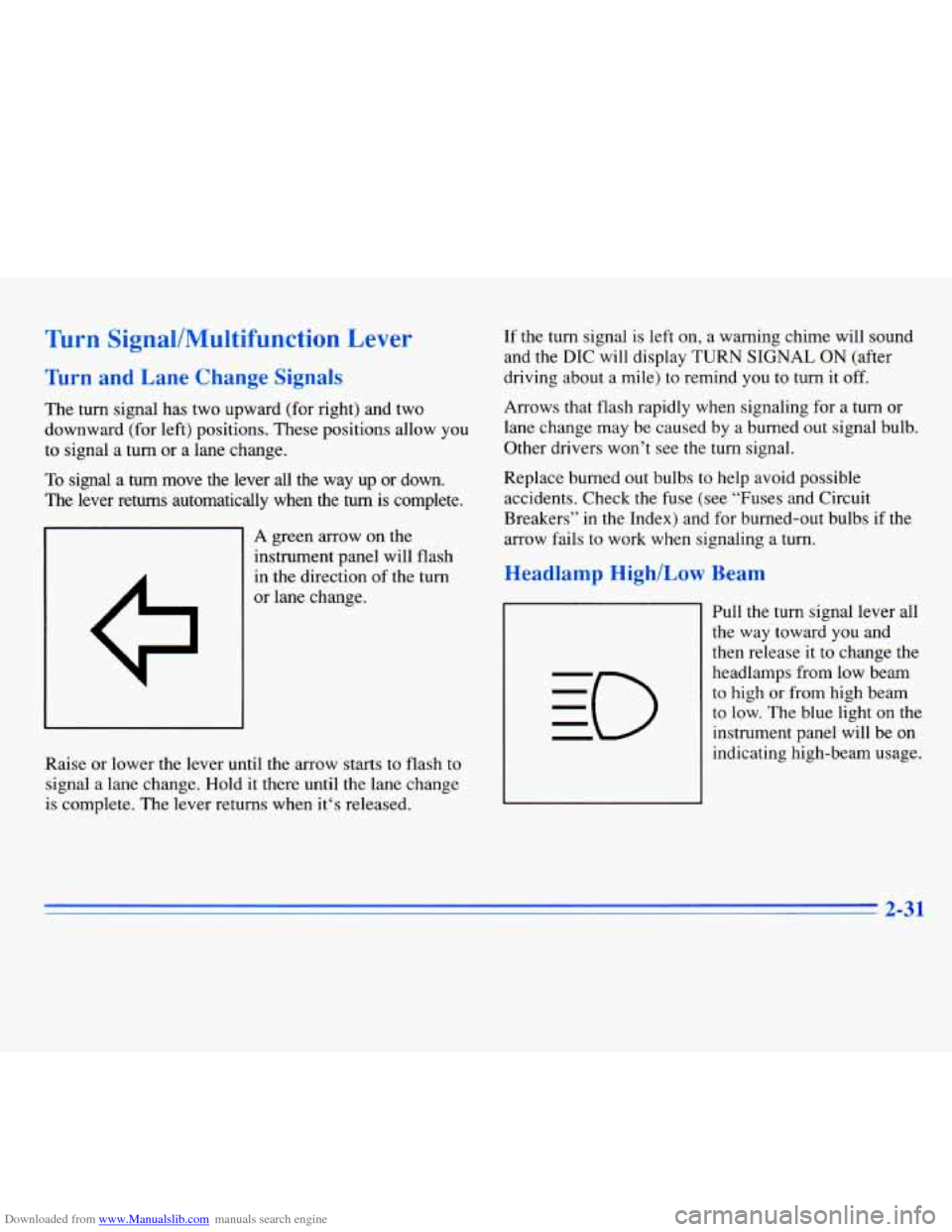
Downloaded from www.Manualslib.com manuals search engine Turn SignallMultifunction Lever
Turn and Lane Change Signals
The turn signal has two upward (for right) and two
downward (for left) positions. These positions allow you
to signal a turn or a lane change.
To signal a turn move the lever all the way up or down.
The lever returns automatically when the
turn is complete.
A green arrow on the
instrument panel will flash
in the direction of the turn
or lane change.
Raise or lower the lever until the arrow starts
to flash to
signal a lane change. Hold it there until the lane change
is complete. The lever returns when it‘s released. If
the turn signal is left on, a warning chime will sound
and the DIC will display TURN SIGNAL ON (after
driving about a mile) to remind you to turn it
off.
Arrows that flash rapidly when signaling for a turn or
lane change may be caused by a burned out signal bulb.
Other drivers won’t see
the turn signal.
Replace burned out bulbs
to help avoid possible
accidents. Check
the fuse (see “Fuses and Circuit
Breakers” in the Index) and for burned-out bulbs
if the
arrow fails to work when signaling a turn.
Headlamp High/Low Beam
Pull the turn signal lever all
the way toward you and
then release it to change the
headlamps from low beam
to high or from high beam
to low. The blue light on the
instrument panel will be on
indicating high-beam usage.
2-31
Page 93 of 354
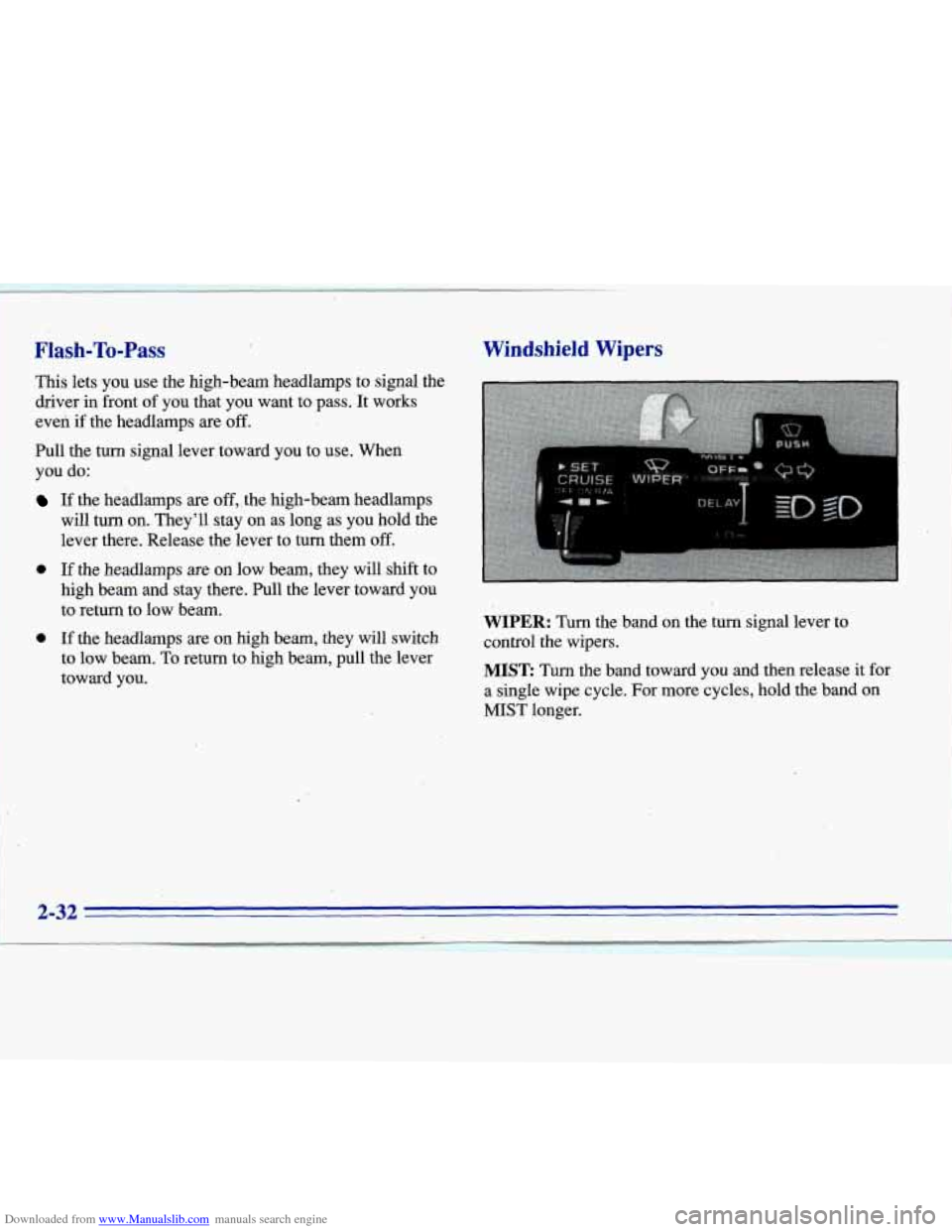
Downloaded from www.Manualslib.com manuals search engine Flash-To-Pass ,
This lets you use the high-beam headlamps to signal the
driver
in front of you that you-want to pass. It works
everi if tfie headlamps are off.
Pull the turn signal lever toward you to use. When
you do:
If the headlamps are off, the high-beam headlamps
will
'turn on. They'll stay on as long as you hold the
lever there. Release the lever
to turn them off.
0 If the headlamps are on low beam, they will shift to
high beam and stay there. Pull the lever toward you
to return
to low beam.
0 If the headlamps are on high beam, they will switch
to low beam. To return to high beam, pull the lever
toward you.
Windshield Wipers
WIPER: Turn the band on the turn signal lever to
control the wipers.
MIST: Turn the band toward you and then release it for
a single wipe cycle. For more cycles, hold the band on
MIST longer.
Page 94 of 354
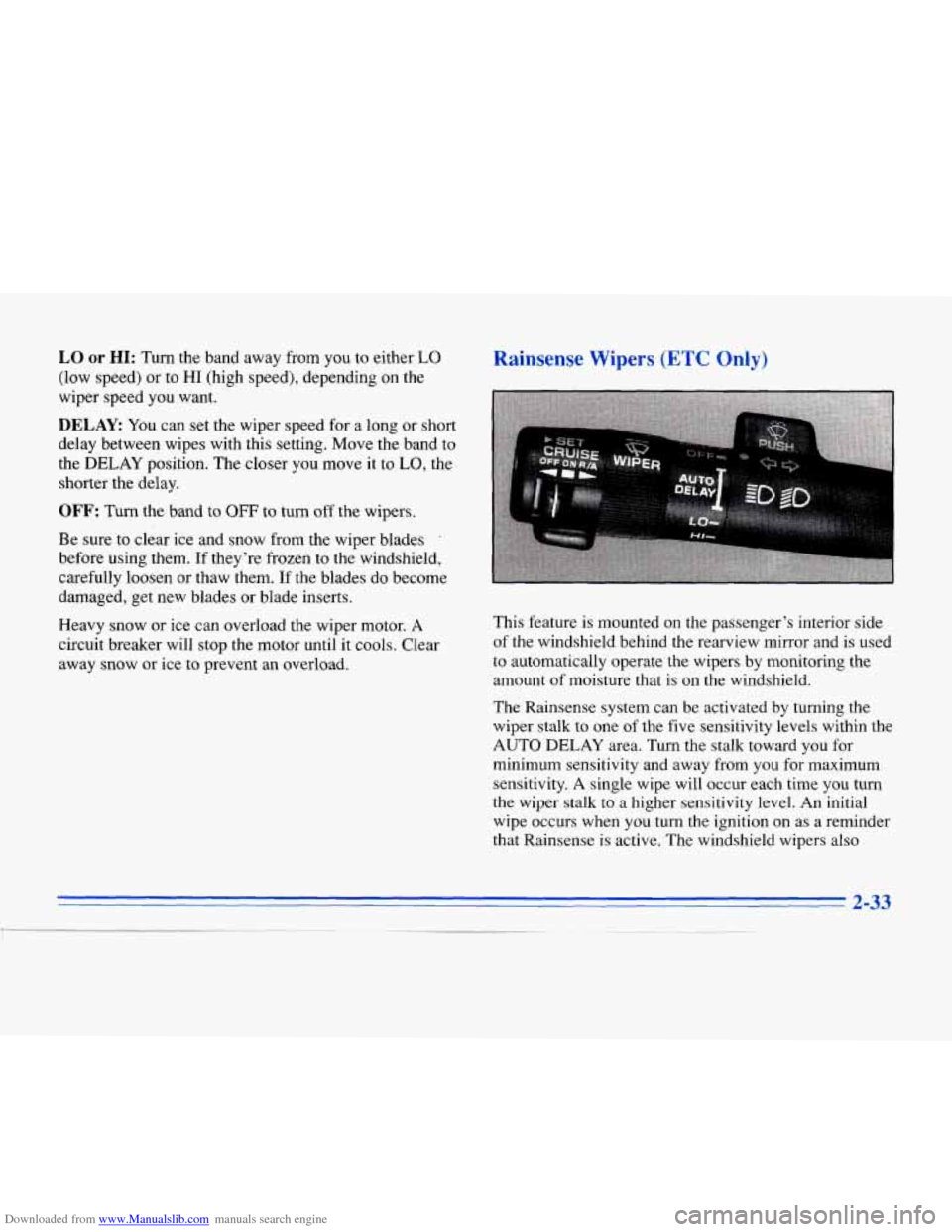
Downloaded from www.Manualslib.com manuals search engine LO or HI: Turn the band away from you to either LO
(low speed) or to HI (high speed), depending on the
wiper speed you want.
DELAY You can set the wiper speed for a long or short
delay between wipes with this setting. Move the band to
the DELAY position. The closer you move
it to LO, the
shorter the delay.
OFF: Turn the band to OFF to turn off the wipers.
Be sure to clear ice and snow from the wiper blades -
before using them. If they’re frozen to the windshield,
carefully loosen or thaw them.
If the blades do become
damaged, get new blades or blade inserts.
Heavy snow or ice can overload the wiper motor. A
circuit breaker will stop the motor until it cools. Clear
away snow or ice to prevent an overload.
Rainsense V- ?ers (ETC Only)
This feature is mounted on the passenger’s interior side
of the windshield behind the rearview mirror and is used
to automatically operate the wipers by monitoring the
amount
of moisture that is on the windshield.
The Rainsense system can
be activated by turning the
wiper stalk to one of the
five sensitivity levels within the
AUTO DELAY area. Turn the stalk toward you for
minimum sensitivity and away from
you for maximum
sensitivity.
A single wipe will occur each time you turn
the wiper stalk to a higher sensitivity level. An initial
wipe occurs when you turn the ignition on as a reminder
that Rainsense is active. The windshield wipers also
~. ~ 2-33
Page 95 of 354
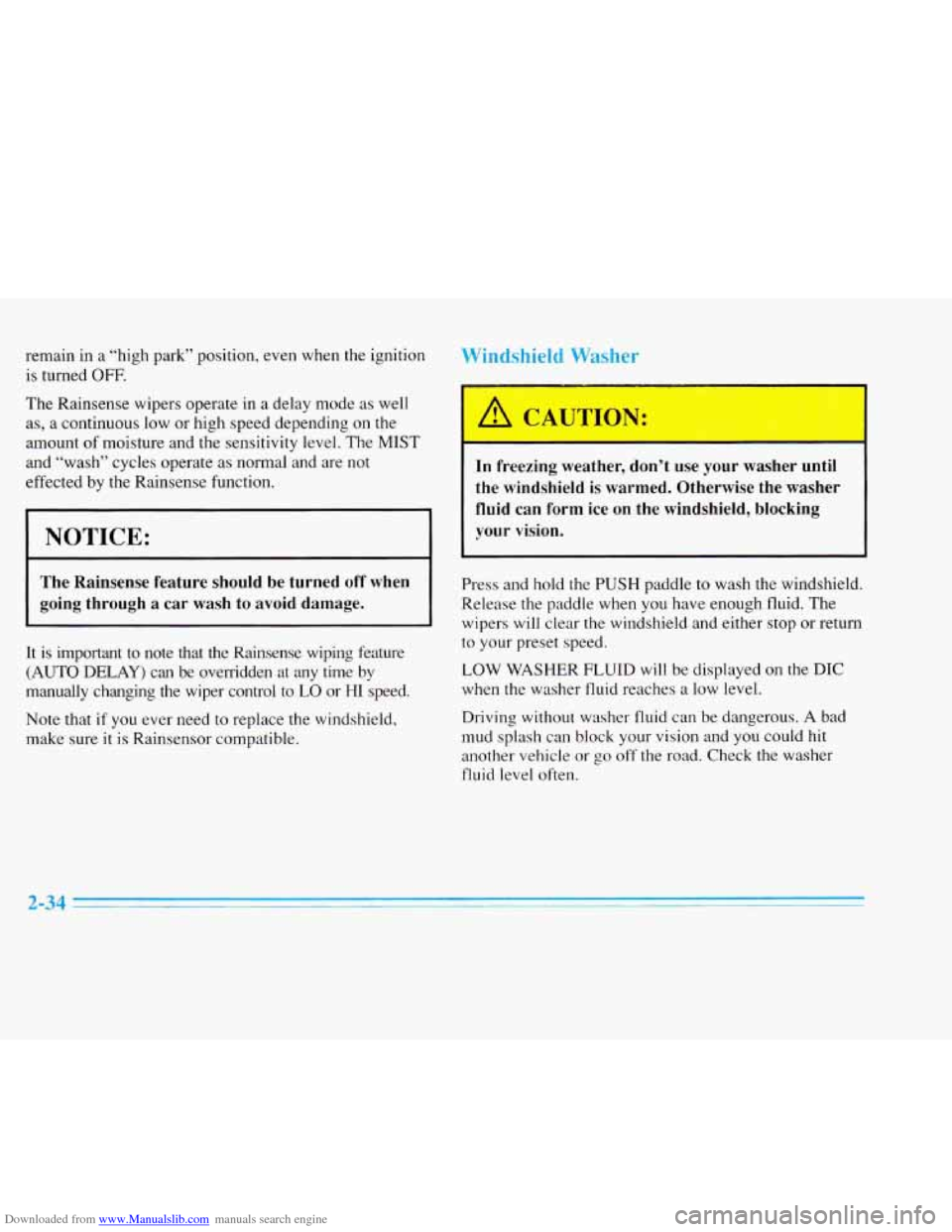
Downloaded from www.Manualslib.com manuals search engine remain in a “high park” position, even when the ignition
is turned
OFF.
The Rainsense wipers operate in a delay mode as well
as, a continuous low or high speed depending on the
amount of moisture and
the sensitivity level. The MIST
and “wash” cycles operate as normal and are not
effected by the Rainsense function.
NOTICE:
The Rainsense feature should be turned off when
going through a car wash to avoid damage.
It is important to note that the Rainsense wiping feature
(AUTO DELAY) can be overridden at any time by
manually changing the wiper control to
LO or HI speed.
Note that if
you ever need to replace the windshield,
make sure
it is Rainsensor compatible.
Windshield Washer
In freezing weather, don’t use your washer until
the windshield is warmed. Otherwise the washer
fluid can form ice
on the windshield, blocking
your vision.
Press and hold the PUSH paddle to wash the windshield
Release the paddle when you have enough fluid. The
wipers
will clear the windshield and either stop or return
to your preset speed.
LOW WASHER FLUID will be displayed on the DIC
when the washer fluid reaches a low level.
Driving without washer fluid can be dangerous.
A bad
mud splash can block your vision and you could hit
another vehicle
or go off the road. Check the washer
fluid level often.
2-34 -
Page 96 of 354
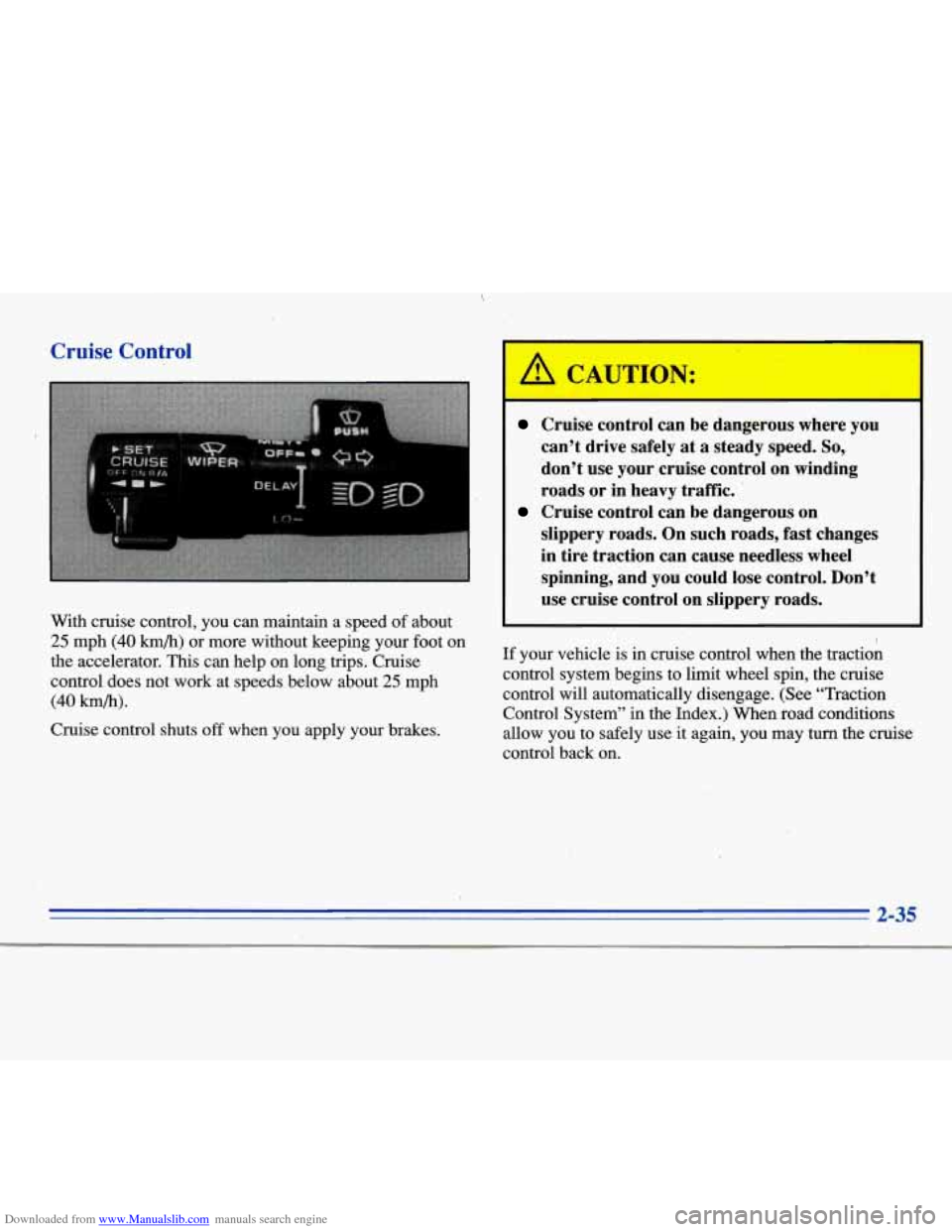
Downloaded from www.Manualslib.com manuals search engine Cruise Control
I
With cruise control, you can maintain a speed of about
25 mph (40 kmb) or more without keeping your foot on
the accelerator. This can help on long trips. Cruise
control does not work at speeds below about
25 mph
(40 hb).
Cruise control shuts off when you apply your brakes.
I
Cruise control can be dangerous where you
can’t drive safely at
a steady speed. So,
don’t use your-cruise control on winding
roads or in heavy traffic.
slippery roads. On such roads, fast changes
in tire traction can cause needless wheel
spinning, and you could lose control. Don’t
use cruise control on slippery roads.
Cruise control can be dangerous on
If your vehicle is in cruise control when the traction
control system begins to limit wheel
spin, the cruise
control will automatically disengage. (See “Traction Control System” in the Index.) When road conditions
allow you to safely use
it again, you may turn the cruise
control back on.
2-35
Page 97 of 354
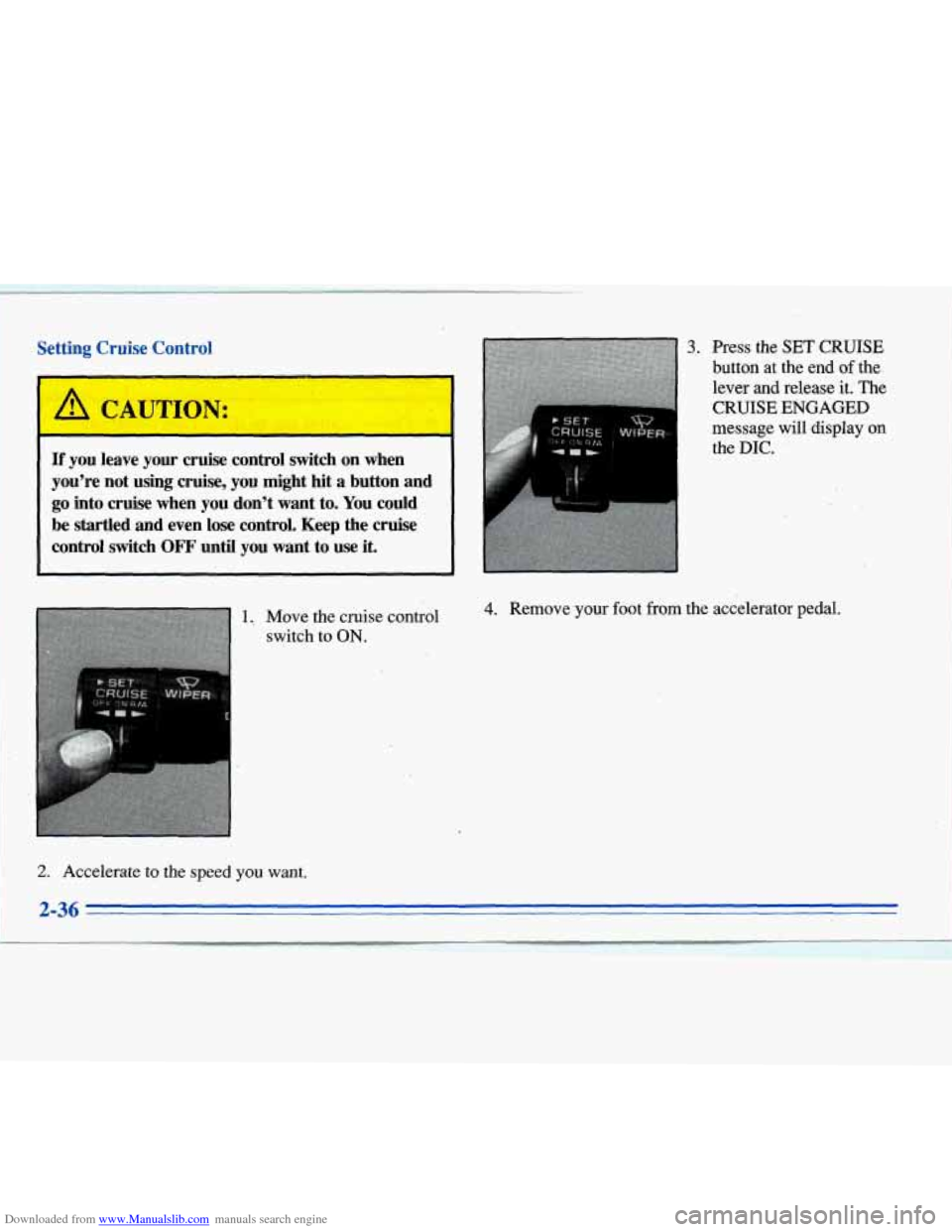
Downloaded from www.Manualslib.com manuals search engine Setting Cruise Control
If you leave your cruise control switch on when
you’re not
using cniise, you might hit a button and
go into cruise when you don’t want to. You could
be startled and even
lose control. Keep the cruise
control
switch OFF until you want to use it.
Press the SET CRUISE
button at the end of the.
lever and release it.
The
CRUISE ENGAGED
message will display on
the DIC.
Move the cruise control
switch to
ON.
4. Remove your foot from the accelerator pedal.
2. Accelerate to the speed you want.
2-36
Page 98 of 354
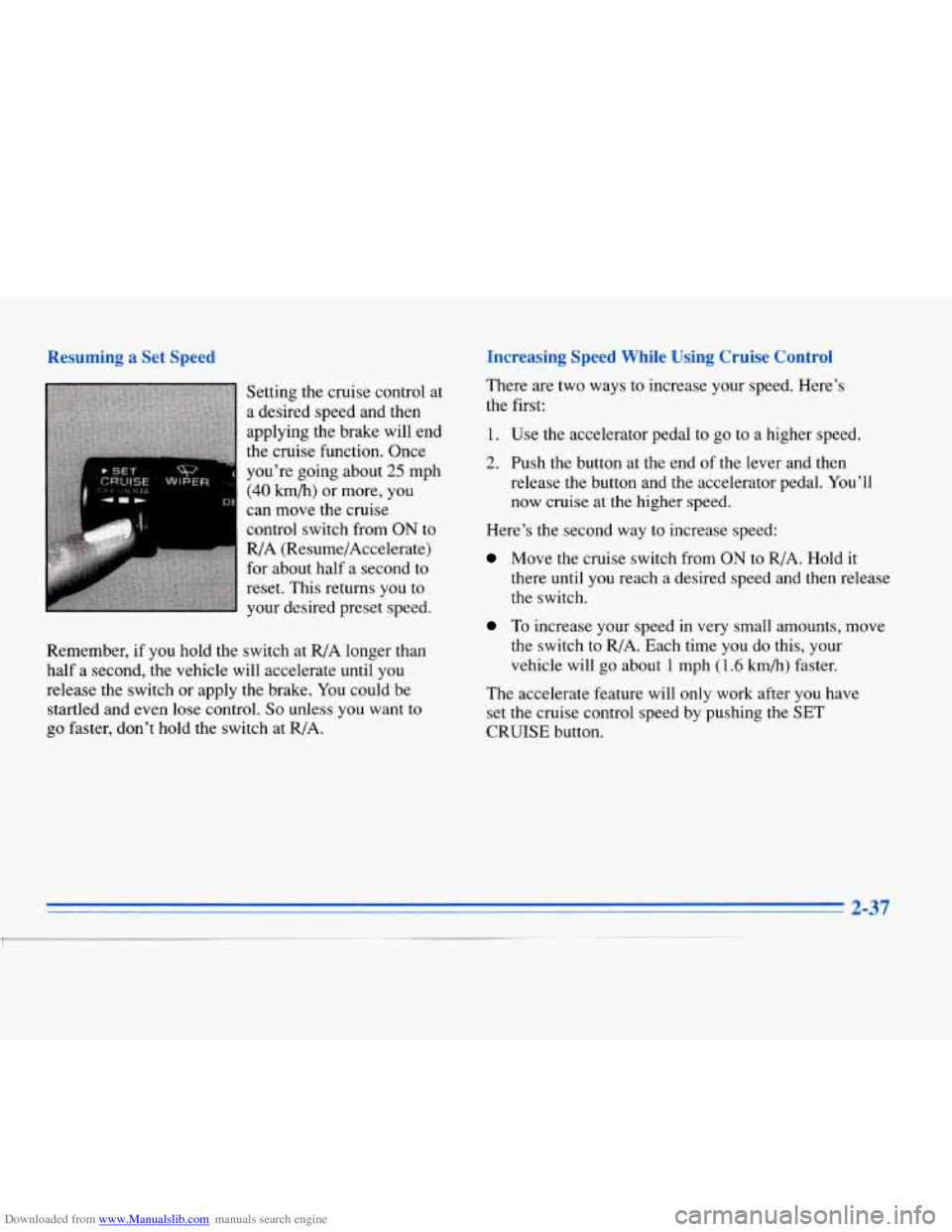
Downloaded from www.Manualslib.com manuals search engine Kernember, if you hold the Setting the
cruise control at
a desired speed and then
applying the brake will end
the cruise function. Once
you’re going about
25 mph
(40 km/h) or more, you
can move the cruise
control switch from
ON to
R/A (Resume/Accelerate)
for about half a second to
reset. This returns you to
your desired preset speed. There are two ways to increase your speed.
Here’s
the first:
1. Use the accelerator pedal to go to a higher speed.
2. Push the button at the end of the lever and then
release the button and the accelerator pedal. You’ll
now cruise at the higher speed.
Here’s the second way to increase speed:
Move the cruise switch from ON to R/A. Hold it
there until you reach a desired speed and then release
the switch.
switch at R/A longer than
half
a second, the vehicle will accelerate until you
release the switch or apply the brake.
You could be
startled and even
lose control. So unless you want to
go faster, don’t hold the switch at R/A.
To increase your speed in very small amounts, move
the switch to R/A. Each time you do this, your
vehicle will
go about 1 mph (1.6 km/h) faster.
The accelerate feature will only work after you have
set the cruise control speed by pushing the
SET
CRUISE button.
Page 99 of 354
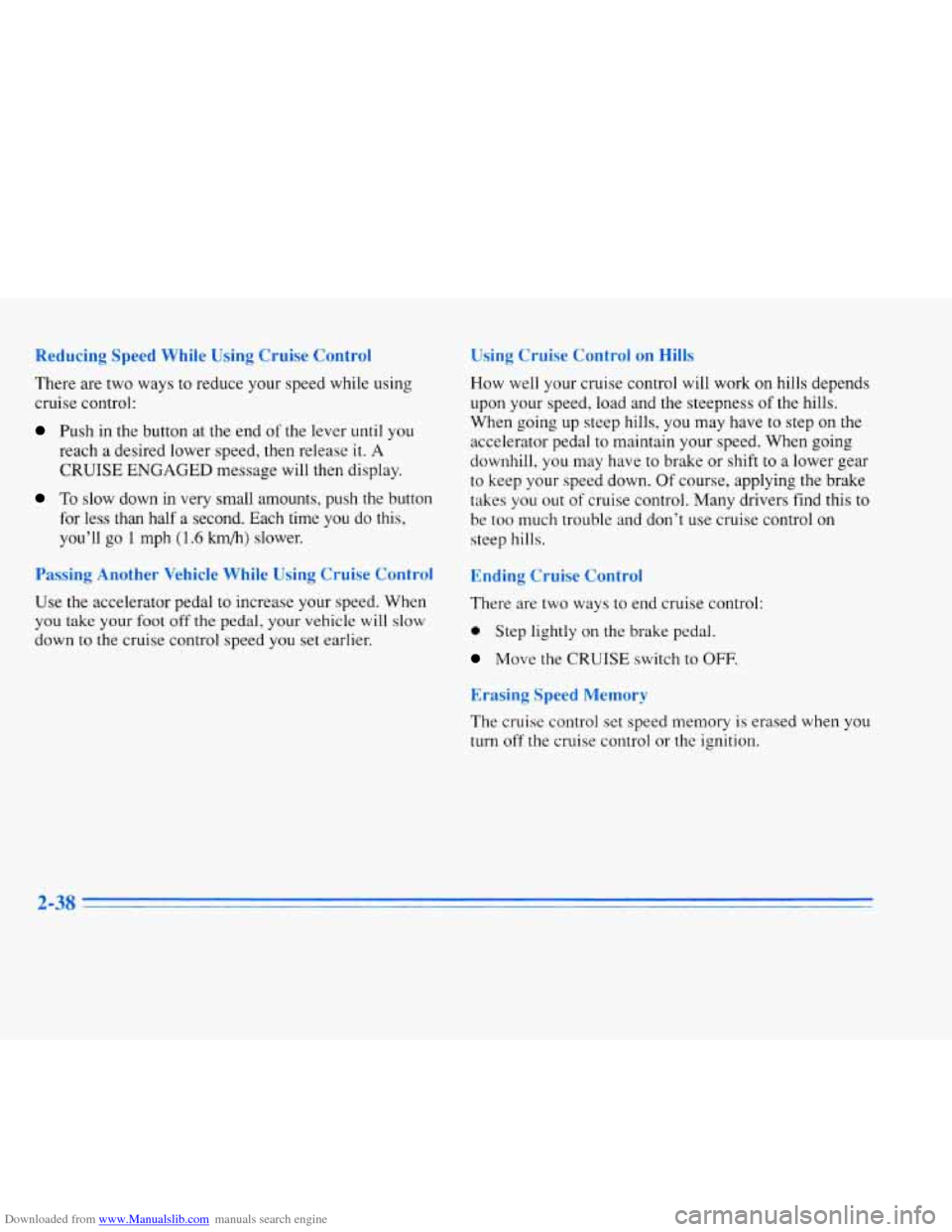
Downloaded from www.Manualslib.com manuals search engine Reducing Speed While Using Cruise Control
There are two ways to reduce your speed while using
cruise control:
Push in the button at the end of the lever until you
reach a desired lower speed, then release
it. A
CRUISE ENGAGED message will then display.
To slow down in very small amounts, push the button
for less than half a second. Each time you do this,
you’ll go
1 mph (1.6 km/h) slower.
Passing Another Vehicle While Using Cruise Control
Use the accelerator pedal to increase your speed. When
you take your
foot off the pedal, your vehicle will slow
down to the cruise control speed you set earlier.
Using Cruise Control on Hills
How well your cruise control will work on hills depends
upon your speed, load and the steepness
of the hills.
When going up steep hills, you may have to step on the
accelerator pedal to maintain your speed. When going
downhill, you may have to brake or shift
to a lower gear
to keep your speed down.
Of course, applying the brake
takes you out
of cruise control. Many drivers find this to
be too much trouble and don’t use cruise control on
steep hills.
Ending Cruise Control
There are two ways to end cruise control:
0 Step lightly on the brake pedal.
Move the CRUISE switch to OFF.
Erasing Speed Memory
The cruise control set speed memory is erased when you
turn
off the cruise control or the ignition.
Page 100 of 354
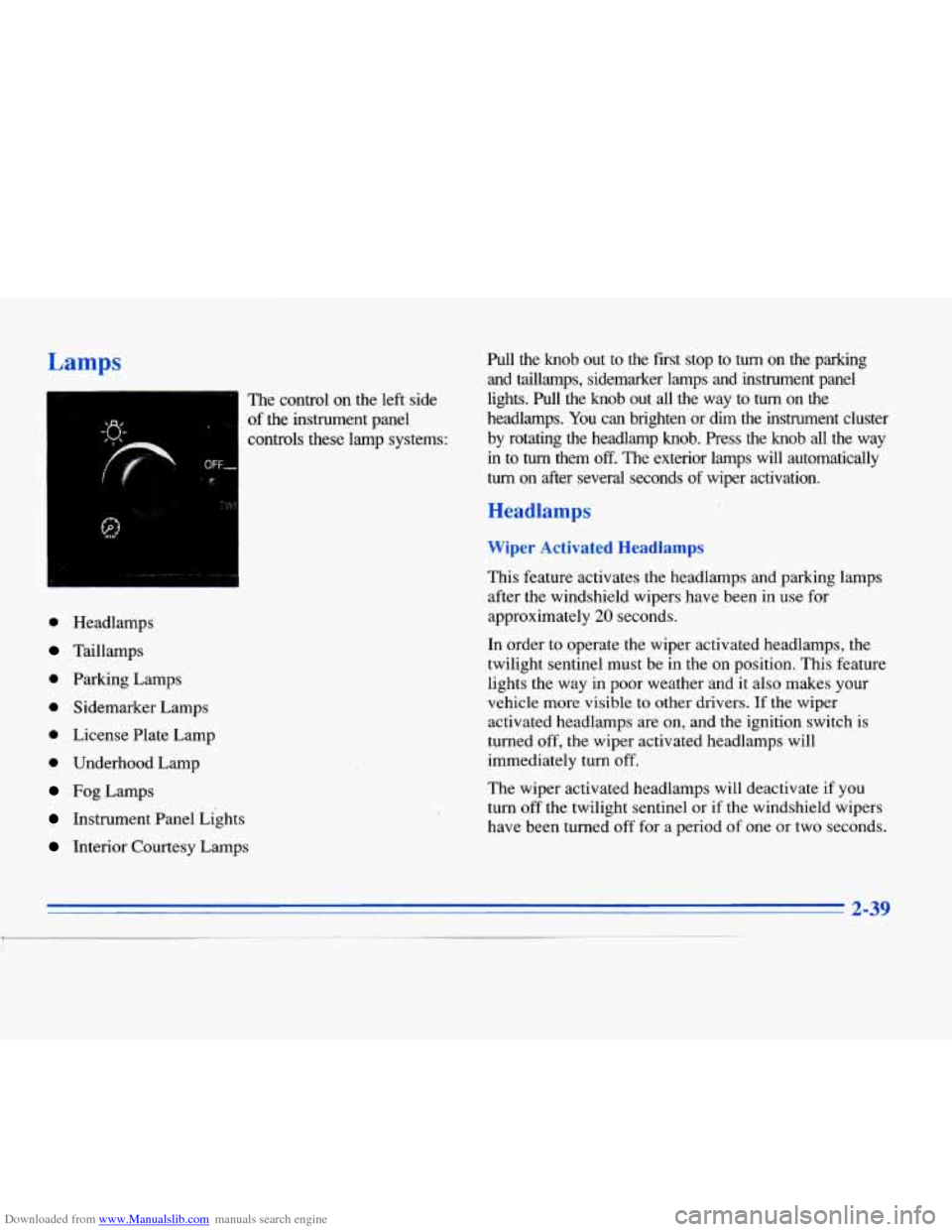
Downloaded from www.Manualslib.com manuals search engine Lamps
I"
..
, __.",
The control on the left side
of the instrument panel
controls these lamp systems:
OFF,
'f"
0 Headlamps
Taillamps
0 Parking Lamps
0 Sidemarker Lamps
0 License Plate Lamp
0 Underhood Lamp
Fog Lamps
Instrument Panel Lights
Interior Courtesy Lamps Pull the knob out to the first stop to
turn on the parking
and taillamps, sidemarker lamps and instrument panel
lights.
Pull the knob out all the way to turn on the
headlamps.
You can brighten or dim the instrument cluster
by rotating the headlamp knob. Press the knob all the way
in to turn them off. The exterior lamps will automatically
turn on after several seconds of wiper activation.
Headlamps
Wiper Activated Headlamps
This feature activates the headlamps and parking lamps
after the windshield wipers have been in use for
approximately
20 seconds.
In order to operate the wiper activated headlamps, the
twilight sentinel must be in the on position. This feature
lights the way in poor weather and it also makes your
vehicle more visible to other drivers.
If the wiper
activated headlamps are on, and the ignition switch is
turned off, the wiper activated headlamps will
immediately turn off.
The wiper activated headlamps will deactivate
if you
turn off the twilight sentinel or
if the windshield wipers
have been turned off for a period of one or two seconds.
2-39